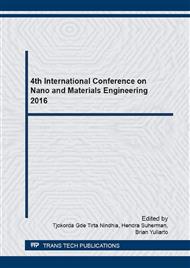[1]
B.A. Baum, Metallic liquids, Nauka, Moscow, (1979).
Google Scholar
[2]
B.A. Baum, G.A. Hasin, G.V. Tyagunov et. al. Liquid Steel, Metallurgia, (1984).
Google Scholar
[3]
A.M. Samarin. Physico-chemical basis of metallurgical processes, Nauka Moscow, (1969).
Google Scholar
[4]
I.P. Prigojin. From Being to Becoming, Nauka Moscow, (2008).
Google Scholar
[5]
K. Yamauchi, Y. Yoshizawa, Recent development of nanocrystalline soft magnetic alloys, Nanostructured Materials. 6 (1995) 247-254.
DOI: 10.1016/0965-9773(95)00048-8
Google Scholar
[6]
B.A. Baum, G.V. Tyagunov, E.E. Baryshev, and V.S. Tsepelev: Equilibrium and nonequilibrium states of metal melts, Fundamental studies of the physical chemistry of metallic melts, Academia Books, 2002, pp.214-228.
Google Scholar
[7]
G. Herzer, Grain structure and magnetism of nanocrystalline ferromagnets, IEEE Trans. Magn. 25 (1989) 3327-3329.
DOI: 10.1109/20.42292
Google Scholar
[8]
G. Herzer, Nanocrystalline soft magnetic alloys, in: K.H.J. Buschow (Ed. ), Handbook of Magnetic Materials. 10 (1997) 415-462.
DOI: 10.1016/s1567-2719(97)10007-5
Google Scholar
[9]
H. Fukunada, N. Furukawa, H. Tanaka, and M. Nakano: Nanostructured soft magnetic material with low loss and low permeability, Appl. Phys. 87 10 (2000) 7103-7105.
DOI: 10.1063/1.372944
Google Scholar
[10]
O.K. Echendu, E.C. Mbamala, and B.C. Anusionwu, Theoretical investigation of viscosity of some liquid metal and alloys, Physical and Chemistry of Liquids. 49 (2011) 247-258.
DOI: 10.1080/00319100903539520
Google Scholar
[11]
V. Tsepelev, V. Konashkov, Y. Starodubtsev, V. Belozerov, and D. Gaipishevarov: Optimum Regime of Heat Treatment of Soft Magnetic Amorphous Materials, IEEE Trans. Magn. 48 4 (2012) 1327-1330.
DOI: 10.1109/tmag.2011.2175209
Google Scholar


